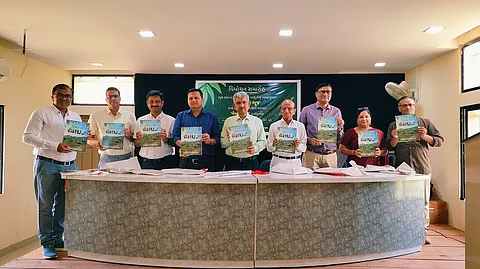

A book titled Trees of Bhuj was launched on March 26, detailing the tree biodiversity of the capital city of Kutch. The latter is the largest district in the country.
The authors of the book are Pankaj Joshi, botanist and researcher, and Ekta Joshi, faculty, Lalan College, Bhuj-Kutch. A web portal (treesofbhuj.in) was also launched the same day, providing detailed information on all the trees documented in the book.
Bhuj is a semi-dryland region rich in biodiversity. It has a vast tree population that plays a crucial role in maintaining ecological balance.
Home In the City (HIC), a collective of non-profits, said in a statement that a mobile application has been developed to map and manage tree data effectively as well as to enhance environmental awareness and sustainable urban planning. HIC has been working on conserving and enhancing biodiversity in Bhuj over the past one-and-a-half decades.
The initiative involves training college students to use the mobile application for collecting, analysing, and utilising tree data. The database currently includes more than 40,000 trees, comprising 127 species of small and large trees. The application enables students to record essential parameters such as species diversity, tree density, and spatial distribution, aiding in strategic plantation planning.
“By leveraging technology, this initiative also aims to engage students, support environmental conservation, and contribute to Bhuj’s urban greening and climate adaptation strategies,” the statement noted.
Using data from the mobile application, a three-tier plantation initiative has been implemented in Bhuj’s urban landscape at the household, society, and ward levels. The selected plant species align with the dominant flora of respective areas, prioritising native species to support biodiversity and balance the ecological food web.
Over the past two years, more than 55 plant species have been selected, and over 7,000 saplings have been planted with a survival rate exceeding 90 per cent across two clusters. In addition, dried saplings have been replaced through seed sowing to maintain the density of native species, particularly in rocky and saline patches.
The plantation drives have been largely supported by private donors, covering approximately 80 per cent of the expenses, including sapling maintenance at multiple sites.
Government departments, such as the Social Forestry team, have provided native and subsidised saplings, while the Bhuj Municipality has supported the initiative by supplying piped water connections and benches, helping transform wastelands into public spaces.
“It is expected that ward-wise action plans that highlight existing rich areas and potential areas for future plantations will help the ward committees and Bhuj Municipality with plantation drives and selecting appropriate plant species for specific locations,” the statement quoted Aseem Mishra, programme director, HIC.
“Conocorpus was found as the second-largest species after neem trees which alarms all of us. There is a need to replace Conocorpus with native species for the sake of conserving biodiversity and human health,” said Pankaj Joshi.
Trees of Bhuj has documented several plant species having medicinal properties such as Tecomella undulata (Ragat Rohido), Derris indica (Karanj), Bauhinia racemosa (Ashitro), Terminalia arjuna (Arjun Sadad), Vitex negundo (Nagod), Cordia gharaf (Gundi- Liyar), Sapindus emarginatus (Aritha), Limonia acidissima (Kothi), Gmelina arborea (Sevan).
This documentation will serve as a valuable reference for citizens and donors supporting plantation drives, as per the statement.